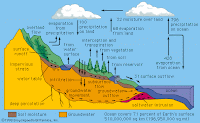The human lung is an example of a 'surface' that has been designed to extract oxygen dissolved in air. A by-product of this process is the loss of water that occurs when we breathe.
The Human Lung
Resembling a sponge, the human lung contains over 70 square feet of surface area for
 |
A microscopic view inside the human lung
Source-www.environmentalgraffiti.com-image 8292 |
absorption of oxygen from the air we breathe.
In an unstressed but not totally relaxed state, an adult typically takes 16 breaths a minute that process nearly 2000 gallons of air in a day.
During such 'normal' breathing, the inhaled air travels at a rate of about 50 mph to the lungs and over the inner surfaces in the lung.
Composition of Inhaled and Exhaled breath
Only a fraction of the oxygen inhaled is extracted by the lungs (Source-Users.ren.com)
|
| Inhaled Atmospheric Air (% volume) | |
| | |
| | |
| | |
| | |
| | |
Exhaled air contains 120 times the moisture in the inhaled air. The typical human, thus, looses about half a liter of water through the act of breathing every day. This exhaled breath has a relative humidity of over a 100% and contains moisture picked up by the air from the moist surfaces of the lungs breathing passages.
Fish Gills
Just like human lungs are designed to extract oxygen from the air, fish gills are designed to extract oxygen dissolved in water.
When compared to water, air has over 20 times as much oxygen. Fish gills do their job in the oxygen-sparse water successfully, because the amount of oxygen required by a cold-blooded fish is very very small compared to that required by warm-blooded humans.
It is for this reason, that whales who are warm-blooded need to surface periodically and 'breathe' the air.
And, it is for this same reason, that human lungs cannot breathe in water because human lungs do not have adequate surface area to extract necessary volumes of dissolved oxygen from water. Of course, evolution also is to blame as the linings of our lungs are probably not designed to function under water as they do in air.
Liquivent
One way to help humans breathe under water would be to increase the amount of dissolved
oxygen in water. Liquivent is just such a product in clinical testing - it is made up of per-fluorocarbons that can dissolve very large amounts of oxygen. It is expected that human lungs will be able to extract greater volumes of Oxygen without undue difficulty from per-fluorocarbons leading to smaller shoulder-tanks to breathe underwater.
Extracting water from air and wind may simply require the creation of a Liquivent-equivalent for water.












